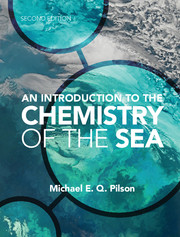Book contents
- Frontmatter
- Contents
- Preface
- Acknowledgments
- 1 Introduction
- 2 The water in seawater
- 3 Salinity, chlorinity, conductivity, and density
- 4 Major constituents of seawater
- 5 Simple gases
- 6 Salts in solution
- 7 Carbon dioxide
- 8 Nutrients
- 9 Trace metals and other minor elements
- 10 Radioactive clocks
- 11 Organic matter in the sea
- 12 Anoxic marine environments
- 13 Exchanges at the boundaries
- 14 Chemical extraction of useful substances from the sea
- 15 Geochemical history of the oceans
- Appendix A The chemical elements
- Appendix B Symbols, units, and nomenclature
- Appendix C Physical properties of seawater
- Appendix D Gases
- Appendix E Carbon dioxide
- Appendix F Dissociation constants and pH scales
- Appendix G Solubility of calcium carbonate
- Appendix H Effects of pressure
- Appendix I Radioactive decay
- Appendix J Geochemical reservoirs, and some rates
- Appendix K Sound absorption
- Epilogue
- Questions for chapters
- Glossary
- References
- Index
- Miscellaneous end matter
- References
4 - Major constituents of seawater
Published online by Cambridge University Press: 05 February 2013
- Frontmatter
- Contents
- Preface
- Acknowledgments
- 1 Introduction
- 2 The water in seawater
- 3 Salinity, chlorinity, conductivity, and density
- 4 Major constituents of seawater
- 5 Simple gases
- 6 Salts in solution
- 7 Carbon dioxide
- 8 Nutrients
- 9 Trace metals and other minor elements
- 10 Radioactive clocks
- 11 Organic matter in the sea
- 12 Anoxic marine environments
- 13 Exchanges at the boundaries
- 14 Chemical extraction of useful substances from the sea
- 15 Geochemical history of the oceans
- Appendix A The chemical elements
- Appendix B Symbols, units, and nomenclature
- Appendix C Physical properties of seawater
- Appendix D Gases
- Appendix E Carbon dioxide
- Appendix F Dissociation constants and pH scales
- Appendix G Solubility of calcium carbonate
- Appendix H Effects of pressure
- Appendix I Radioactive decay
- Appendix J Geochemical reservoirs, and some rates
- Appendix K Sound absorption
- Epilogue
- Questions for chapters
- Glossary
- References
- Index
- Miscellaneous end matter
- References
Summary
The solid matter in seawater, though strictly speaking, and we may add necessarily, of a very complex composition, consists substantially of the muriates and sulfates of soda, magnesium, lime and potash.
William Dittmar 1884All the chemical elements in the periodic table that can be found on Earth (Appendix A) must be present to some extent in seawater, although not quite all have been detected there yet. For a variety of reasons it is convenient to consider separately the major and minor constituents. In this chapter only the major constituents will be considered. In a continuum of concentrations, any separation is arbitrary, but it is convenient to pick a value of one part in one million (=1 ppm or 1 mg/kg) as a lower limit for the concentrations of major constituents. Substances present above this concentration may have a detectable influence on the density, for example, while those present in lesser concentrations will, individually at least, generally not. Most of the substances that occur in concentrations greater than 1 mg/kg are conservative – that is, they are found in nearly constant proportions to each other and to the salinity. Most of the substances present in concentrations of less than 1 mg/kg are not conservative.
As defined above, there are 11 substances included among the major constituents, and there are a couple more that could be included but conventionally have not been.
- Type
- Chapter
- Information
- An Introduction to the Chemistry of the Sea , pp. 66 - 73Publisher: Cambridge University PressPrint publication year: 2012
References
- 6
- Cited by

